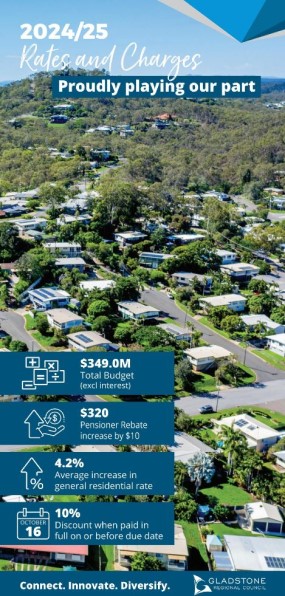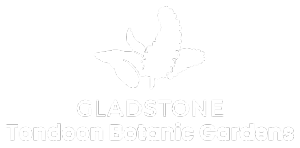Living Here
- Pets and Animals
- Residents
- Report
- Environment
- BackEnvironment
- Air Quality
- Biodiversity
- Biosecurity
- Blue-green algae blooms
- Bushfire Mitigation
- Coasts and Coastal Vegetation
- CoastSnap
- Conservation Programs and Initiatives
- Erosion and Sediment Control
- Feral Animals
- First Nations Fire and Land Officer
- Landfill Gas Abatement
- Mosquitoes
- Pests and Weeds
- Weed Spray Equipment Hire
- Wildlife
- Community Development
- Community Investment
- Services
- Emergencies
Utility Charges
Service charges
Water meter readings
Water meter readings in the Gladstone Regional Council area occur twice a year:
- in June/July and
- November/December.
Council staff undertaking water meter readings will be dressed in GRC-branded clothing and carry an authorised officer card featuring photographic identification.
Residents are requested to assist the meter readers by keeping any unrestrained dogs under control and gates closed. Please ensure that water meters are accessible and not covered with building materials, topsoil, vehicles, etc. If you cannot locate your meter, phone Council on (07) 4970 0700.
Where Advanced Water Meters are installed, they will be used to collect reading data that will be provided to Council's system to maintain the current six-monthly billing cycle.
Monitor your water usage by regularly taking readings.
See also Advanced Water Meters
Waste Management Facility charge
A Waste Management Facility Charge will be levied equally on all land within the Gladstone Region. Recognising that all ratepayers utilise local Waste Management Facilities, Council has introduced a separate Waste Management Facility Charge of $70 per property.
Waste levy payment
As a landfill operator, Council pays a waste levy to the Queensland government based on the amount of waste disposed to landfill. The waste levy aims to make waste processing more sustainable and thereby reduce the amount of waste going to landfill. The levy will not affect the cost of residents putting out their kerbside wheelie-bins. The Queensland government is providing quarterly advance payments to Council to mitigate any direct impacts of the waste levy on households. The total amount that will be paid to Council by the Queensland Government for this purpose for the 2024/25 financial year is $1,930,548. Find out more online.
Other charges
State Emergency Management Levy
Council levies and collects the State Emergency Management Levy on behalf of the State Government for the Queensland Fire and Emergency Services.
In previous years, this levy has been known as the Annual State EMFR Levy, State Government Fire Levy or Urban Fire Levy.
The Urban Fire Levy Scheme was introduced in 1984 to partially fund the Queensland Fire Service. Since then the Fire Service and the Levy have both evolved.
Today we have the Queensland Fire and Emergency Services (QFES), one organisation with many services, working with their partners in the community to plan for and mitigate the full range of natural and other hazards faced. QFES delivers its emergency management services through the Fire and Rescue Service, Rural Fire Service Queensland and the State Emergency Service and the Emergency Management Levy remains its primary source of funding.
The Levy is established in the Fire and Emergency Services Act 1990 (the Act) which applies a levy on properties within levy districts. The Act places a legal obligation on local governments to administer the levy, which is collected through local government rate notices.
The Levy is applied to all Queensland property to ensure there is a sustainable funding base for the fire and emergency services and recognises that all Queenslanders are at risk from a wide range of emergencies including floods, cyclones, storms as well as fire and accidents.
To discuss how Council has determined the State Emergency Management Levy classification on your assessment please contact the Revenue Services team on (07) 4970 0700.For further information regarding this levy please visit the QFES website or call 13 74 68. A discount does not apply to the State Emergency Management Levy.
Continuous flow scheme advice (Trickle feed)
Please be aware that Council has undertaken a change in our continuous flow scheme (trickle feed). Further information can be found here.
Continuous flow schemes (trickle feed) are water supply schemes specifically designed for acreage type developments to deliver a required quantity of water on a continuous low flow basis.
To fully utilise the supply, it is necessary to provide sufficient on-site storage to collect and store all water not immediately consumed. Storage facilities, particularly those used for domestic consumption, should be fully enclosed. Open structures, like dams, should be avoided since most of the water would be lost through evaporation and seepage. Where elevated storage cannot be provided on-site, a small pressure system may be required to ensure that adequate flow and pressure is achieved.
Continuous flow schemes (trickle feed) are not designed to cater for fire fighting flows. Property owners are required to make their own arrangements in this regard.
Flow is controlled by means of a special restrictor valve which is designed to deliver a uniform flow rate, irrespective of pressure (within the limits set by the manufacturer). Council will not guarantee the instantaneous flow rates.
Service connections located above the elevations mentioned below are likely to suffer severe reductions in flow, particularly as more and more properties are connected to the scheme. Consequently, Council will take no responsibility for any reduction in flow rate, where the storage facility, or any inlet pipework, is above these elevations.
- All properties between Mount Elizabeth and the intersection of Weeroona Road/Dawson Highway – RL80m (AHD)
- All properties in Chamberlain Road and along the Dawson Highway to Clyde Creek – RL 60m (AHD)
- All properties north of Clyde Creek including Wyndham, Schultz, Jefferis & Siding Roads – RL 50m (AHD)
While Council may be able to assist to some extent in relation to contour levels, it is the property owners’ responsibility to determine and ensure that they do not exceed these maximum service levels.
As with urban schemes Council is responsible for the operation and maintenance of the system up to and including the service connection assembly and meter, which is normally located mostly outside or sometimes inside the property boundary. All pipework, fittings, tanks, pressure systems etc installed beyond this point are the responsibility of the property owner.
The flow control valve installed with the meter assembly will normally guarantee a continuous flow rate. If required Council officers will carry out testing at the connection point to ensure that each service receives its flow, continuously, the size of the valve may be adjusted at Council’s discretion, to ensure that this is achieved.
With the exception of the stopcock (on the customer side after the meter), which may be turned on or off as required, it is an offence to interfere in any way with any other fittings or pipework installed at the connection point.
All property owners are required to provide and maintain their own on-site storage facilities and all pipework between the connection point and storage tank. Property owners are also responsible for the provision and maintenance of any internal pressure system and the protection of the connection point itself.
All storage tanks connected to the reticulated water supply must be provided with an air gap on the storage inlet (ie: there must be a gap between the top water level and the inlet pipe) or a backflow prevention device to avoid contamination. The installation of a float control valve on the tank inlet would normally ensure that an air gap is provided.
The delivery line between the connection point and the storage tank should be direct to avoid any possibility of backflow. Where in the Council’s opinion, such a possibility exists, a backflow prevention device may be fitted to the on-customer side of the connection point, at the property owners’ expense. Under no circumstances shall any internal pressure system be connected to the delivery line between the connection point and the storage facility inlet.
The size of the on-site storage facility will depend on personal usage patterns, however a capacity in the order of 45,000 litres (10,000 gallons) would normally be adequate.
Should any storage facilities exist and be less than 45,000 litres, it is suggested that such facilities be retained and upgraded only if they are not sufficient to cater for peak demands (ie: if the tank regularly runs dry or nearly dry).
The service line between the connection point and the storage tanks should be equivalent to class 12 polyethylene, as quite high pressures may be experienced if the line is isolated. The size of the service is up to the individual property owner, however, 25mm or 32mm O.D. lines are quite common and normally quite adequate for this type of scheme.
Where possible, Council officers will liaise with property owners and attempt to provide water connections at nominated locations. As a general rule, where properties are large (eg greater than 5 Ha) and where the main is on the same side of the road as the property, Council will install the service at any (reasonable) nominated point.
Where the main is on the opposite side of the road it may be necessary to cross the road at one of the side boundaries. In any event, property owners are encouraged to sketch the desired location of their service connection point on the back of the water application form to permit a preliminary inspection.
The following charges apply to all new participants within the defined scheme area:
- Scheme headworks charge
- Water connection ‘at actual cost’ (minimum fee applies)
- Annual water charge (depending on size of the service installed).
Details on the defined scheme area and the above charges are available on request.
Living Here
- Pets and Animals
- Residents
- Report
- Environment
- BackEnvironment
- Air Quality
- Biodiversity
- Biosecurity
- Blue-green algae blooms
- Bushfire Mitigation
- Coasts and Coastal Vegetation
- CoastSnap
- Conservation Programs and Initiatives
- Erosion and Sediment Control
- Feral Animals
- First Nations Fire and Land Officer
- Landfill Gas Abatement
- Mosquitoes
- Pests and Weeds
- Weed Spray Equipment Hire
- Wildlife
- Community Development
- Community Investment
- Services
- Emergencies
Gladstone Regional Council
Connect. Innovate. Diversify.
Get in Touch
Phone
(07) 4970 0700
Opening Hours
8.30am - 5pm Monday to Friday
Social media
Postal Address
PO Box 29, Gladstone Qld 4680
Council Offices
101 Goondoon Street, Gladstone Qld 4680
3 Don Cameron Drive, Calliope Qld 4680
41 Blomfield Street, Miriam Vale Qld 4677
Cnr Wyndham & Hayes Avenues, Boyne Island Qld 4680
Rural Transaction Centres
71 Springs Road, Agnes Water Qld 4677
47 Raglan Street, Mount Larcom Qld 4695
Footer Acknowledgement
Gladstone Regional Council would like to acknowledge the Bailai, the Gurang, the Gooreng Gooreng and the Taribelang Bunda people who are the traditional custodians of this land. Gladstone Regional Council would also like to pay respect to Elders both past, present and emerging, and extend that respect to other Aboriginal and Torres Strait Islander people. Learn more about Council's Reconciliation Action Plan (RAP).
Chat Popup
All content © Gladstone Regional Council. All Rights Reserved.
Back to the top








